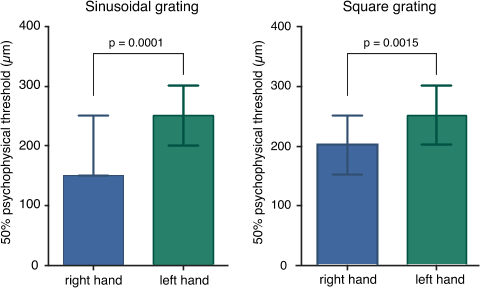




read more











In the future, the authors would like to investigate if these results generalize to lefthanded users, which would confirm the importance of hand dominance. As well, a potential use of different sensory thresholds of finger types, which the authors found in their study, is to leverage these sensitivities to novel finger identification techniques on tactile displays [ 8, 19 ] in order to allow users to perform different interaction tasks.
While hand dominance is most likely the driving force behind variable sensitivity, it is possible that perceptual differences could result from left-right physiological differences.
The 1-up-1-down staircase procedure offers the compelling advantage of reducing the total time of their experiment, since the authors investigate a high number of trials and conditions for each participant.
Their results indicate that the index and the thumb are the most sensitive fingers for perceiving differences in spatial textures for both sine and square virtual gratings; the little finger, followed by the ring, is the least sensitive for texture perception in one-finger exploration for the two types of gratings.
This enhanced perception sensitivity permits the dominant hand to control exploratory motion in order to optimize the consistency of tactile feedback across fingers.
Current commercial touchscreen devices rarely provide a compelling haptic feedback to human fingers despite the use of touch as input; haptic feedback is typically limited to vibration.
The little finger was the least sensitive, i.e., had the highest perceptual threshold level in all conditions, and the ring finger was the second least sensitive in all conditions.
In terms of implications, for designers, these results provide guidance on the need to vary haptic stimuli depending on whether the stimulus is designed for the dominant or non-dominant hand, depending on whether it is designed for the index finger or for any finger, and depending on whether it is to be a single-finger of multi-finger interaction.